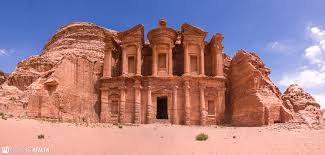
Petra Jordan
A Comprehensive Review
Petra, often called the “Rose City” because of the color of the stone, is one of the most famous archaeological sites in the world. Located in the southwestern desert of Jordan, Petra is a UNESCO World Heritage Site and one of the New Seven Wonders of the World. It was the capital of the Nabatean Empire and a major trading center in ancient times.
Here is a detailed overview of Petra’s key highlights and features:
Suk is a narrow, winding gorge that serves as the main entrance to Petra. It is about 1.2 km (0.75 mi) long and is flanked by high cliffs, some as high as 80 meters (262 ft). Walking through the Sec is a magical experience, as the path suddenly reveals Petra’s most famous monument—the Treasury—at the end.
2. Treasury (al-khazna).
The Treasury, or Al Khaznia, is the most recognizable structure in Petra. Carved in pink sandstone, it is about 40 meters (131 ft) high and 25 meters (82 ft) wide. Originally believed to be the tomb of a Nabataean king, it is famous for its intricate facade and Hellenistic architectural influences. The treasure is believed to be from the first century AD.
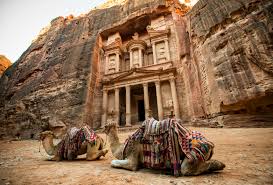
3. Monastery (Ad-Dir)
The monastery is another vast structure in Petra, even larger than the Treasury. Located high in the mountains and accessible after climbing about 800 steps, it is believed to have been a tomb or temple of the Nabateans. It has a simpler but more impressive facade than the Treasury, which is 50 meters (164 ft) high and 45 meters (148 ft) wide. Its location offers spectacular views of the surrounding area.
4. Royal tombs
The royal tombs are a series of grand facades and burial sites carved into the rocks of Petra, which probably served as resting places for the Nabatean royal family and elite. These tombs include the Urn Tomb, the Silk Tomb, the Corinthian Tomb, and the Palace Tomb. Each of these structures displays a combination of Nabataean, Greek and Roman architectural styles.
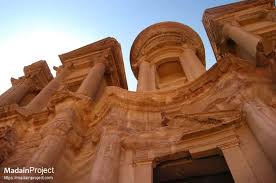
5. Colonnade Street
Colonnaded Street, also known as Roman Street, runs through the heart of Petra. It was once the main thoroughfare of the city, lined with shops, temples and public buildings. The street was redesigned in Roman times when they annexed Petra in AD 106, and its columns show the Roman influence on the city’s architecture.
6. The Great Temple
The Great Temple is one of the largest and most important structures in Petra, believed to be a central religious and ceremonial complex. Excavations have revealed multiple levels and rooms, including a large courtyard, stairways, and colonnades. Its sheer scale and complexity indicate that it was a key structure in plant society.
7. The high place of sacrifice
The High Place of Sacrifice is a sacred site on a mountain above Petra. It can be reached by a steep climb and was used by the Nabataeans for religious ceremonies including animal sacrifice. The site offers beautiful views of Petra and the surrounding desert.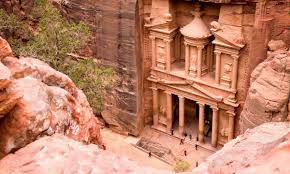
8.The Nabateans
were an ancient Arab people who made Petra their capital in the 4th century BC. They were skilled traders and controlled the spice and incense trade routes that passed through the region. Their wealth allowed them to build the magnificent structures seen in Petra today, which reflect a combination of Nabataean, Egyptian, Greek and Roman influences.
9. Petra’s Water Management System
Petra is known for its sophisticated water management system, which allowed the city to thrive in the arid desert environment. The Nabataeans built an extensive network of dams, reservoirs and channels to collect and store rainwater. This system provided water for the city’s residents and gardens, making Petra a lush oasis in the desert.
10. Al Bayda (Little Petra)
Al Bayda, also known as “Little Petra”, is a small archaeological site located just a few kilometers north of Petra. It was a satellite community of Petra and served as a suburb for traders and travelers. The site contains similar rock-cut tombs and structures, albeit on a smaller scale.
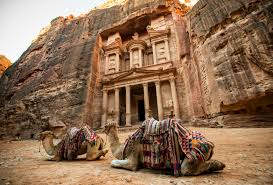
11. Petra Church
Petra Church is an important Byzantine-era structure located within the site. It has well-preserved mosaics depicting scenes of animals and people. It provides an insight into the continued occupation and importance of Petra during the Byzantine period, long after the fall of the Nabatean monarchy.
12. Petra by night
“Petra by Night” is a magical event where the Sake and Treasury are illuminated by candlelight. Visitors can walk through the Sake in the dark and experience the treasury bathed in the soft glow of hundreds of candles, accompanied by traditional Bedouin music and storytelling.
13. UNESCO World Heritage Site
In 1985, Petra was declared a UNESCO World Heritage Site, recognizing its outstanding universal value. Petra has been described as “one of the most valuable cultural features of man’s cultural heritage”. Its combination of historical significance, architectural grandeur and natural beauty make it an important cultural and archaeological landmark.14. Tourism and Conservation
Today, Petra is Jordan’s most visited tourist attraction, attracting tourists from all over the world. However, the site faces challenges, including erosion, climate change, and the effects of tourism. Efforts are being made to preserve and protect Petra, ensuring that its ancient wonders are preserved for future generations
what is petra Jordan famous for?
Rock-cut Architecture:
Treasury (Al Khaznah):
Nabataean Civilization:
Water Management System:
Archaeological significance:
UNESCO World Heritage Site:
New Seven Wonders of the World:
Film location:
what is the mystery of petra ?

1. The Uncertain Origin of the Nabataeans
While Petra became the capital of the Nabatean Empire around the 4th century BC, the origins of the Nabateans themselves remain unclear. The Nabataeans were nomadic Arab traders who founded Petra, but where they came from and how they developed such superior skills in architecture, engineering and trade is a matter of debate among historians.
2. The Purpose of the Treasury (Al-Khazna)
One of the greatest mysteries of Petra is the true purpose of the Treasury or Al Khaznia. Although it is often considered a royal tomb, its exact function remains unknown. Local legends believe that it was a place to hide treasure, hence its name. However, there is no conclusive evidence to confirm this. The absence of inscriptions further adds to speculation about its original use.
3. Advanced engineering and water management
Petra’s water management system is a remarkable feat of engineering, especially for a desert city. The Nabateans built an intricate network of dams, reservoirs, and water channels to harness and store rainwater. How they developed this advanced technology and how they maintained a thriving city in such a harsh environment continues to fascinate researchers.
4 . Monastery (Ad-Deir)
Like the treasury, the purpose of the monastery, another elaborate structure at Petra, is not fully understood. Its size and isolation suggest that it may have been used for religious ceremonies, but the exact nature of these ceremonies or its wider significance remains a mystery. As with many other structures at Petra, the lack of inscriptions has left archaeologists guessing.

5. Nabatean Cultural Fusion
Petra’s architecture is an unusual blend of Nabataean, Greek, Roman, Egyptian, and even Mesopotamian influences. The Nabataeans were a trading people who absorbed many cultural elements from the empires they interacted with, but how they managed to blend these diverse styles so seamlessly into their structures is still a mystery. The debate continues. This reflects a high level of sophistication for the nomadic culture.
6. Hidden and unexplored areas
Petra extends far beyond the well-known treasury and monastery. Archaeologists believe that large parts of the city, including some of its tombs and underground chambers, remain unexplored. Excavations continue to reveal new structures, and some scholars believe that much of Petra’s history is still buried beneath the sand, waiting to be discovered.
7. Religious Worship and Rituals
The Nabateans were known to worship a variety of gods and goddesses, but their religious practices are somewhat of a mystery. Sites such as the High Place of Sacrifice indicate that they performed ritual sacrifices, but not about the exact nature of their rituals, the pantheon of gods they worshipped, or how they integrated religion into their daily lives. I have very little information.
8. The Decline and Abandonment of Petra
Another mystery surrounding Petra is the reason for its decline and eventual abandonment. The city flourished as an important trading center for several centuries, but by the 7th century AD, it was largely abandoned. Although historians point to factors such as changes in trade routes and a series of earthquakes, the exact reasons for the city’s decline are not fully understood. Why such a developed city fell into obscurity is a subject of study.
9. Rediscovery of Petra
After being forgotten by the Western world for centuries, Petra was rediscovered in 1812 by the Swiss explorer Johann Ludwig Burkhart. However, the local Bedouin tribes had known about the city for a long time, and its location was well kept secret. The fact that such a large and important city could be “lost” for so long adds to Petra’s air of mystery.
10. Underground Chambers and Hidden Tombs.
Some scholars believe that many of Petra’s most valuable or historically important artifacts are still hidden in underground chambers or unexcavated tombs. Several monuments suggest the existence of hidden chambers beneath Petra’s surface, and researchers continue to explore whether more treasure, art, or inscriptions may be found.
Conclusion:
Petra is a place of many mysteries—its origins, its structures, and the sophisticated Nabatean society that built it. Although much has been uncovered, much remains unknown, adding to the allure of this ancient wonder.





